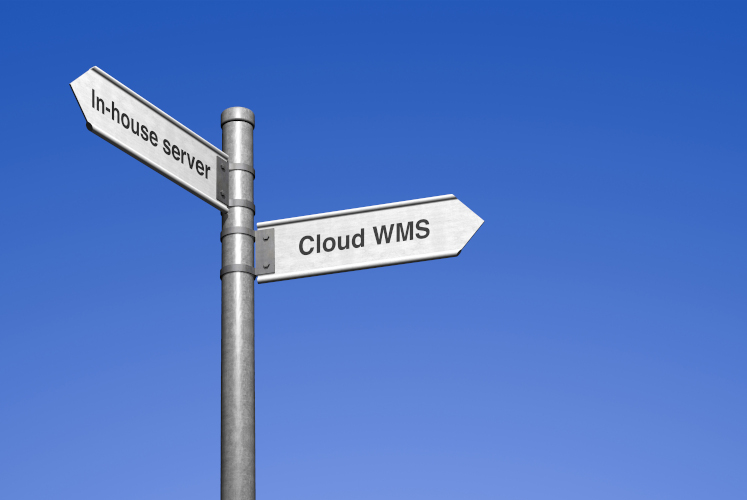In the past, a medium-sized business wanting to enhance its warehouse operations with a capable, affordable warehouse management system (WMS) faced difficult choices.
WMS Benefits
A WMS can deliver real benefits in efficiency and productivity performance by supporting better working processes, promoting accuracy and sharing information faster.
But formerly the choice was often between a simple, but inadequate control package, or an over-specified mid-level enterprise system.
The latter often involved big upfront costs in software, equipment and internal resource. But more recently, advanced cloud-based WMS applications have changed this.
Server Based WMS
In recent years the server-based WMS has reached an advanced stage of development, with high-level functionality, extensively configurable options, broad modular scope and multiple integration options. Typically, although usually based on ‘standard’ software, many users consider their system a starting point, something to grow and develop with their business. So in time if not at first, these systems are enhanced with customised extras, in effect making them semi-bespoke solutions.
For larger more mature businesses with adequate internal resources, this may be key to IT strategy. With ample personnel to specify development, implement changes, and manage infrastructure it is practical and desirable to have a system shaped around your business needs. But for smaller-scale enterprises with fewer people and less expertise, this may not be the best choice. The continued improvement of cloud-hosted inventory management systems suggests there is now a valid alternative.
Advantages and disadvantages of In house WMS
There is no doubt that a system that adapts to business change provides something extra.
If your challenge is to onboard new customers and products, or embrace new markets all of which need different working methods, a system that keeps pace will mean a competitive advantage.
This does assume any changes you need are delivered at a sensible cost in timescales that align with your business changes.
An efficient in-house IT resource or external supplier who understands and responds quickly is clearly essential in achieving this.
But there are downsides. Funding an in-house IT department to develop and maintain a system is expensive.
A cynical person might observe that it can be an expanding cost centre, while a truly cynical one might add that it can even start to affect the primary function of a business!
There are pitfalls too with external suppliers. Not only can you become dependent on them, but sometimes on their specific employees. If your system is extensively customised this can also make regular annual support, as well as system upgrades (where possible) increasingly expensive.
Cloud Hosted WMS
An alternative option, generally but not exclusively suited to the medium-scale enterprise is the cloud-hosted WMS.
Pros
Though not always competitive on functionality with leading established WMS’, some are now developed to a level that satisfies the majority of typical user needs.
In addition, they offer faster implementation, lower set up and training costs and ongoing rental that can be met from operating budgets.
Inclusive support and upgrades, and particularly for web-dependent enterprises standard API connectivity, are also plus points.
Of course, there are some drawbacks.
Cons
Some cloud WMS may never offer the same features and configurability you could get with your own ‘semi-bespoke’ system.
This is because the more developed a system is, the more complex the underlying code.
With a multi-tenanted system – one used in standard form by many companies – it makes support more complex when reliability must be key.
So there is a trade-off between using a cost-effective system giving most of what you need, and accepting that, standard upgrades aside, you will not get everything you want.
Best Solution is Based on Your Business
It’s a decision to make based on your own business situation.
There are good reasons to have a system you can adapt, and for some that’s essential.
That you also manage your IT infrastructure means you control your destiny in terms of both software and hardware.
Those things cannot be achieved with a cloud-hosted WMS, yet as the better systems continue to improve there are sound reasons why they could be the right choice for your business.
There is some compromise, but it could deliver greatly reduced cost and management time compared to the alternative.
Server-based WMS |
Cloud-Hosted WMS |
✓ Pros |
|
| Greater range of ‘advanced’ features | Most essential functionality covered |
| More configurable options | Short implementation timescale |
| Can bespoke to exact needs | Low initial set-up costs |
| Infrastructure under your control | Rental cost from operating budgets |
| Scalability with extra modules | Fixed ongoing cost – easier budgeting |
| Higher level support may be available | Support included in monthly fees |
| On-premise solution – no reliance on Internet | Upgrades usually included |
| In-house server and resilience | Dev costs shared across users |
| Lower training costs | |
| Easy to cost Justify and show ROI | |
| Lower ‘dependency’ – not unique to user | |
| Likely to have standard plug-ins/integration | |
| Server and resilience provide by vendor | |
| Lower hardware expenditure | |
✘ Cons |
|
| Big upfront investment | Fewer ‘advanced’ features |
| Lengthy implementation time | Less configurable |
| Involved set-up due to system complexity | Potentially less scalable |
| Bigger training investment | Unlikely to offer ‘bespoke’ additions |
| Upgrades can be complex/expensive | Infrastructure not under your control |
| Support ‘dependency’ with bespoke solution | Support may be less customer-centric |
| Gradually increasing support fees | Reliance on Internet quality |
| Extra bespoke work may be costly | |
| Potential waiting time for changes | |
| Integration may not be standard | |
| May pay for unwanted functionality | |






